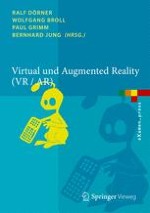2013 | OriginalPaper | Buchkapitel
2. Wahrnehmungsaspekte von VR
verfasst von : Prof. Dr. Ralf Dörner, Prof. Dr. Frank Steinicke
Erschienen in: Virtual und Augmented Reality (VR / AR)
Verlag: Springer Berlin Heidelberg
Aktivieren Sie unsere intelligente Suche, um passende Fachinhalte oder Patente zu finden.
Wählen Sie Textabschnitte aus um mit Künstlicher Intelligenz passenden Patente zu finden. powered by
Markieren Sie Textabschnitte, um KI-gestützt weitere passende Inhalte zu finden. powered by
